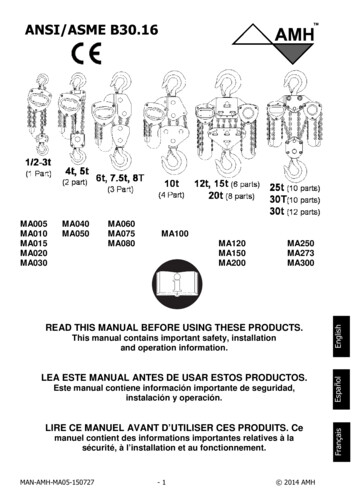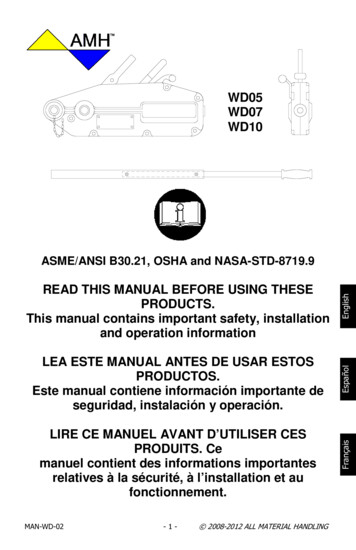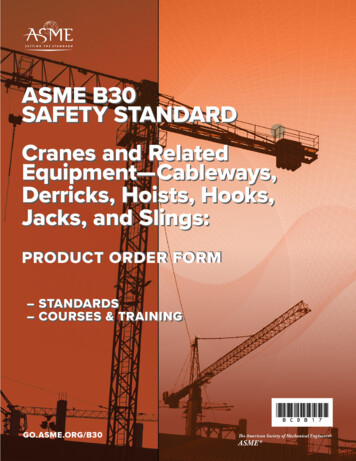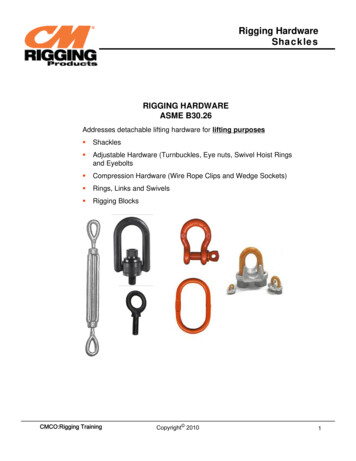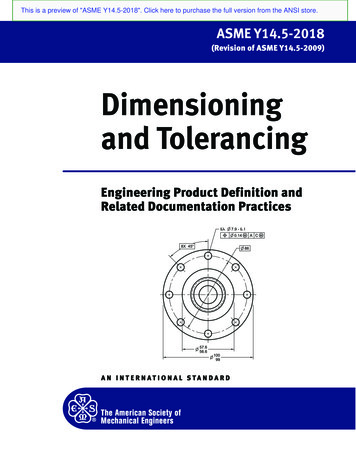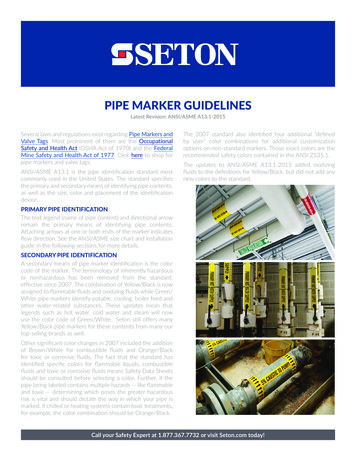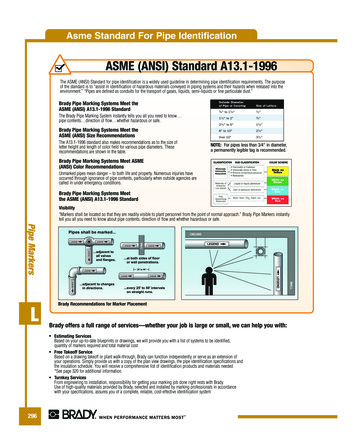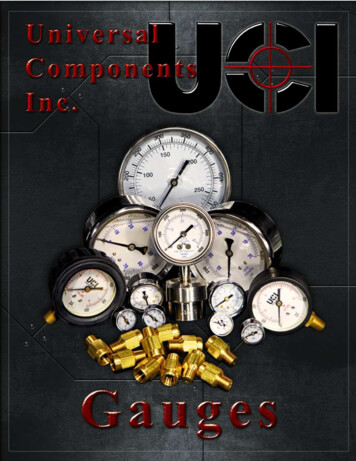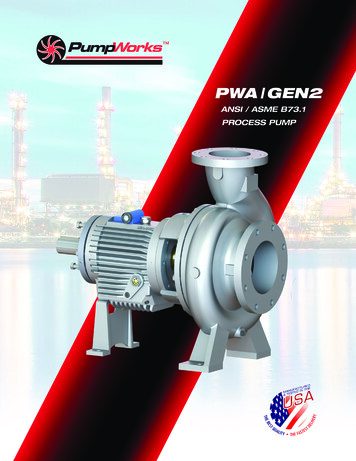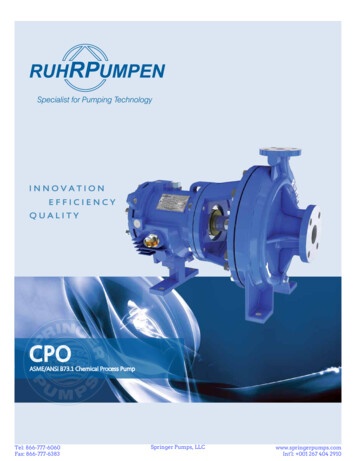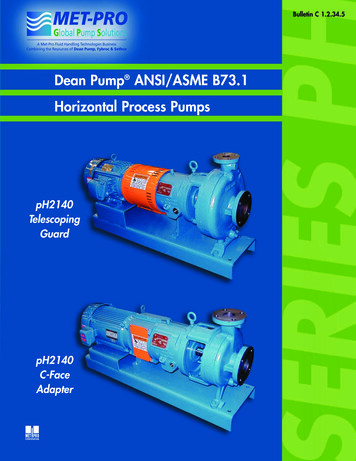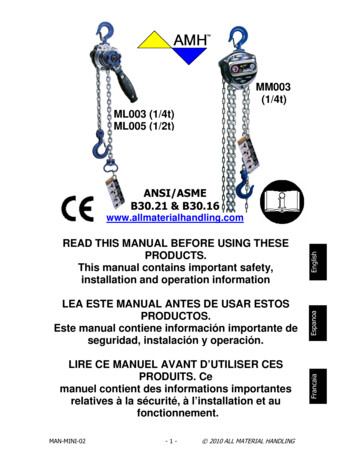
Transcription
MM003(1/4t)ML003 (1/4t)ML005 (1/2t)ANSI/ASMEB30.21 & B30.16READ THIS MANUAL BEFORE USING THESEPRODUCTS.This manual contains important safety,installation and operation informationEnglishLEA ESTE MANUAL ANTES DE USAR ESTOSPRODUCTOS.Este manual contiene información importante deseguridad, instalación y operación.EspanoaLIRE CE MANUEL AVANT D’UTILISER CESPRODUITS. Cemanuel contient des informations importantesrelatives à la sécurité, à l’installation et omMAN-MINI-02-1- 2010 ALL MATERIAL HANDLING
This manual provides important information for all personnel involved with the safe installationand operation of these products. Even if you feel you are familiar with this or similar equipment,you should read this manual before operating the product.EnglishAMH recognizes that most companies who use hoists have a safety program in force in theirplants. In the event you are aware that some conflict exists between a rule set forth in thispublication and a similar rule already set by an individual company, the more stringent of the twoshould take precedence. Safe Operating Instructions are provided to make an operator aware ofunsafe practices to avoid and are not necessarily limited to the following list. Refer to specificsections in the manual for additional safety information. Safe Operating Instructions areprovided to make an operator aware of unsafe practices to avoid and are not necessarily limitedto the following list.1. Only allow people, trained in safety andoperation of this product, to operate the hoist.2. Only operate a hoist if you are physically fit to doso.3. When a “DO NOT OPERATE” sign is placed onthe hoist, do not operate the hoist until the signhas been removed by designated personnel.4. Before each shift, the operator should inspect thehoist for wear or damage.5. Never use a hoist which inspection indicates isworn or damaged.6. Periodically, inspect the hoist thoroughly andreplace worn or damaged parts.7. Lubricate the hoist regularly.8. Do not use hoist if hook latch has been sprung orbroken.9. Check that the hook latches are engaged beforeusing.10. Never splice a hoist chain by inserting a boltbetween links.11. Only lift loads less than or equal to the ratedcapacity of the hoist. See "SPECIFICATIONS"section.12. When using two hoists to suspend one load,select two hoists each having a rated capacityequal to or more than the load. This providesadequate safety in the event of a sudden loadshift.13. Never place your hand inside the throat area of ahook.14. Never use the hoist load chain as a sling.15. Never operate a hoist when the load is notcentered under the hook. Do not “side pull” or“yard.”16. Never operate a hoist with twisted, kinked,“capsized” or damaged load chain.17. Do not force a chain or hook into place by hammering.18. Never insert the point of the hook into a chain link.19. Be certain the load is properly seated in the saddle of the hook and the hook latch isengaged.20. Do not support the load on the tip of the hook.21. Never run the load chain over a sharp edge.22. Pay attention to the load at all times when operating the hoist.23. Always ensure that you, and all other people, are clear of the path of the load. Do not lift aload over people.MAN-MINI-02-2- 2010 ALL MATERIAL HANDLING
24. Never use the hoist for lifting or lowering people, and never allow anyone to stand on asuspended load.25. Do not use a cheater bar or extender handle.26. Do not swing a suspended load.27. Never weld or cut on a load suspended by the hoist.28. Never use the hoist chain as a welding electrode.29. Do not operate hoist if chain jumping, excessive noise, jamming, overloading, or bindingoccurs.30. Only operate the hoist with manual power.31. After use, or when in a non-operational mode the chain hoist should be secured againstunauthorized and unwarranted use.32. Do not leave a load suspended when the hoist is unattended or not in use.1.2.3.4.STORING THE HOISTAlways store the hoist in a no load condition.Wipe off all dirt and water and hang in a dry place.Oil the chain, hook pins and hook latch pins.Before returning hoist to service follow instructions for ‘Hoists not in Regular Service’ in theRecords and ReportsSome form of inspection record should be maintained for each hoist, listing all points requiringperiodic inspection. A written report should be made monthly on the condition of the criticalparts of each hoist. These reports should be dated, signed by the person who performed theinspection, and kept on file where they are readily available for review.Frequent InspectionOn a hoist in continuous service, frequent inspection should be made at the beginning of eachshift. In addition, visual inspections should be conducted during regular service for any damageor evidence of malfunction.1. OPERATION. Check for visual or abnormal noises which could indicate a potential problem.Do not operate a hoist unless the load chain feeds through the hoist and hook blocksmoothly. Listen for “clicking”, binding or malfunctioning. The clicking sound of the pawl onthe ratchet gear is normal when a load is being raised. If chain binds, jumps, or isexcessively noisy, clean and lubricate the chain. If problem persists, return the hoist to yournearest repair center. Do not operate the hoist until all problems have been corrected. Checkthat hand chain moves freely and without binding or excessive drag. Hook should stopmoving when hand chain stops moving.2. HOOK LATCH. Check operation of the hook latch. Replace if broken or missing.3. HOOKS. Check for wear or damage, increased throat width, bent shank or twisting of hook.Replace hooks which exceed the throat opening discard width (15%) shown in Table 1 (ref.Dwg. H-01) or exceed a 10 twist (ref. Dwg. H-01). If the hook latch snaps past the tip of thehook, the hook is sprung and must be replaced. Check hooks swivel easily and smoothly.Repair or lubricate as necessary.4. CHAIN (ref. Dwg. C-01). Examine each of the links for bending, cracks in weld areas orshoulders, transverse nicks and gouges, weld splatter, corrosion pits, striation (minuteparallel lines) and chain wear, including bearing surfaces between chain links. Replace achain that fails any of the inspections. Check lubrication and lubricate if necessary. See‘Load Chain’under LUBRICATION.”MAN-MINI-02-3- 2010 ALL MATERIAL HANDLINGEnglish“INSPECTION”Frequent and periodic inspections should be performed on equipment in regular service.Frequent inspections are visual examinations performed by operators or service personnelduring routine hoist operation. Periodic inspections are thorough inspections performed bypersonnel trained in inspection and maintenance of the hoist. Careful inspection on a regularbasis will reveal potentially dangerous conditions while still in the early stages, allowingcorrective action to be taken before the condition becomes dangerous.Deficiencies revealed through inspection, or noted during operation, must be reported to anappointed person. A determination must be made as to whether a deficiency constitutes a safetyhazard before resuming operation of the hoist.
5. LOAD CHAIN REEVING. Make sure welds on standing links are away from load sheave.Reinstall chain if necessary. Check that the last link of the load chain is securely connected.Make sure chain is not capsized, twisted or kinked. Adjust as required.Periodic InspectionEnglishFrequency of periodic inspection primarily depends on the severity of yDisassembly may be required for HEAVY or SEVERE usage. Keep accumulative written recordsof periodic inspections to provide a basis for continuing evaluation. Inspect all items in “FrequentInspection.” Also inspect the following:1. FASTENERS. Check rivets, capscrews, nuts, cotter pins and other fasteners on hooks, hoistbody and chain bucket, if used. Replace if missing and tighten or secure if loose.2. ALL COMPONENTS. Inspect for wear, damage, distortion, deformation and cleanliness. Ifexternal evidence indicates the need for additional inspection return the hoist to your nearestservice repair center.3. HOOKS. Inspect hooks for cracks. Use magnetic particle or dye penetrant to check forcracks. Inspect hook retaining parts. Tighten or repair, if necessary. Refer to applicablespecifications for additional hook inspection information.4. CHAIN SHEAVES. Check for damage or excessive wear. If damage or wear is noted, returnthe hoist to your nearest service repair center.5. LOAD CHAIN. Measure the chain for stretching by measuring across five link sections allalong the chain (ref. Dwg. C-01). When any five links in the working length reach or exceedthe discard length shown in Table, replace the entire chain. Always use a genuine AMHreplacement chain.6. BRAKES. Raise a load equal to the rated capacity of the hoist a few centimeters (inches) offthe floor. Verify hoist holds the load without drift. If drift occurs, contact your nearest servicerepair center for repair information.7. SUPPORTING STRUCTURE. If a permanent structure is used inspect for continued ability tosupport load.8. LABELS AND TAGS. Check for presence and legibility. Replace if necessary.9. END ANCHOR. Ensure end anchor on hoist is installed and unbent. Repair if damaged,replace if missing.Hoists not in Regular Service1. Hoists which have been idle for a period of one month or more, but less than one yearshould be given an inspection conforming with the requirements of "Frequent Inspection"before being placed in service.2. Hoists which have been idle for a period of more than one year should be given a completeinspection conforming with the requirements of "Periodic Inspection" before being placed inservice.3. Standby hoists should be inspected at least semi-annually in accordance with therequirements of "Frequent Inspection." In abnormal operating conditions equipment should beinspected at shorter intervals.LubricationGeneralThe use of thread lubricant or anti-seize compound is recommended for threaded components.Unless otherwise stated, remove old lubricant, clean the part with an acid free solvent and applya new coating of lubricant to the part before assembly.GearsUnscrew nuts on the opposite side of the hoist as the hand chain, and remove gear cover andsupport plate. Remove old grease and replace with new. For temperatures -29 to 10 C (-20 to50 F) use EP 1 grease or equivalent. For temperatu res -1 to 49 C (30 to 120 F) use EP 2grease or equivalent.MAN-MINI-02-4- 2010 ALL MATERIAL HANDLING
Load Chain1. Lubricate each link of the load chain weekly. Apply new lubricant over existing layer.2. In severe applications or corrosive environment, lubricate more frequently than normal.3. Lubricate hook and hook latch pivot points with the same lubricant used on the load chain.4. To remove rust or abrasive dust build-up, clean chain with acid free solvent. After cleaning,lubricate the chain.5. Use a SAE 50 to 90 EP oil.1 YEAR LIMITED WARRANTYEnglishWe make every effort to assure that our products meet high quality and durability standards andwe warrant to the original consumer of our products that each product be free from defects inmaterial and workmanship as follows:1 Year limited warranty on all our products. The warranty does not apply to defects due directlyor indirectly to misuse, negligence or accidents, repairs or alterations outside our facilities or to alack of maintenance. We limit all warranties to the period specified above from the date theproduct was purchased at retail. Please retain your dated sales receipt as proof of purchase tovalidate the warranty period. Except as stated herein, any implied warranties or merchantabilityand fitness are excluded. Some states do not allow limitations on how long the warranty lasts;hence the above limitation may not apply to you. We shall in no event be liable for death, injuriesto persons or property or for incidental, contingent, special or consequential damages arisingfrom the use of our products. Some states do not allow the exclusions or limitation of incidentalor consequential damages; hence the above limitations or exclusions may not apply to you. Totake advantage of this warranty, the product must be returned for examination, postage prepaidto an authorized service station. Proof of purchase date and an explanation of the complaintmust accompany the product. If our inspection discloses a defect we will either repair or replacethe product or refund the purchase price, if we cannot quickly provide a repair or replacement, ifyou are willing to accept such a refund. We will return repaired products or the replacement atour expense, but if we find that there is no defect, or that the defect resulted from causes notwithin the scope of this warranty, then the user must bear the cost of returning the product. Thiswarranty gives you specific legal rights, and you may also have other rights that vary from stateto state.MAN-MINI-02-5- 2010 ALL MATERIAL HANDLING
Este manual ofrece información importante para todo el personal involucrado con la instalacióny operación segura de estos productos. Incluso en el caso de que usted considere que conocebien este equipo, u otro semejante, debe leer este manual antes de operar este producto.EspanoaAMH reconoce que la mayoría de compañías que utilizan polipastos tienen un programa deseguridad vigente en sus plantas. En el caso de que usted se entere de la existencia deconflicto entre una norma establecida en esta publicación y una semejante ya establecida poruna compañía determinada, tendrá prioridad la más exigente de las dos. Las Instrucciones parala operación segura se proporcionan para alertar al operador sobre las prácticas inseguras quese deben de evitar, y no necesariamente se limitan a la lista que sigue a continuación. Paraobtener más información de seguridad, consulte las secciones específicas del manual.1. Sólo se debe permitir que operen el polipasto
21. Never run the load chain over a sharp edge. 22. Pay attention to the load at all times when operating the hoist. 23. Always ensure that you, and all other people, are clear of the path of the load. Do not lift a load over people. English
